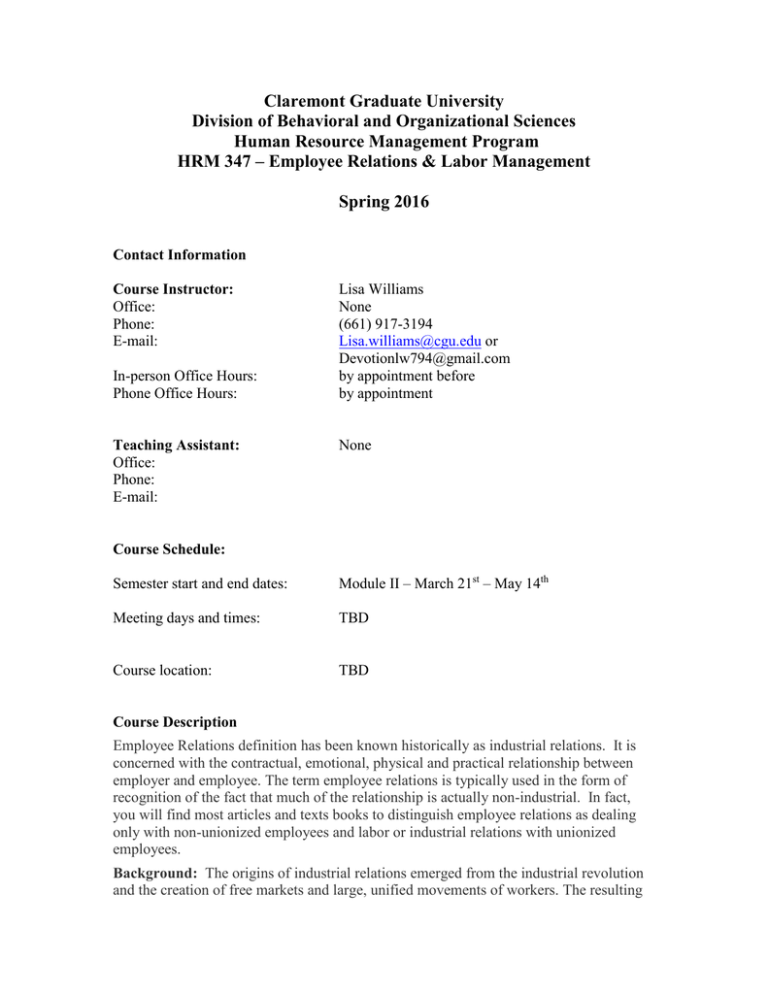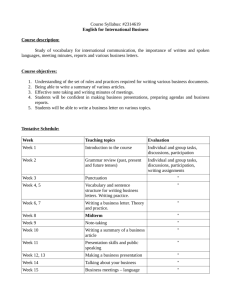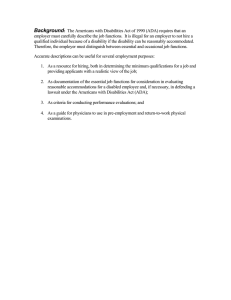Claremont Graduate University Division of Behavioral and Organizational Sciences
advertisement

Claremont Graduate University Division of Behavioral and Organizational Sciences Human Resource Management Program HRM 347 – Employee Relations & Labor Management Spring 2016 Contact Information Course Instructor: Office: Phone: E-mail: In-person Office Hours: Phone Office Hours: Teaching Assistant: Office: Phone: E-mail: Lisa Williams None (661) 917-3194 Lisa.williams@cgu.edu or Devotionlw794@gmail.com by appointment before by appointment None Course Schedule: Semester start and end dates: Module II – March 21st – May 14th Meeting days and times: TBD Course location: TBD Course Description Employee Relations definition has been known historically as industrial relations. It is concerned with the contractual, emotional, physical and practical relationship between employer and employee. The term employee relations is typically used in the form of recognition of the fact that much of the relationship is actually non-industrial. In fact, you will find most articles and texts books to distinguish employee relations as dealing only with non-unionized employees and labor or industrial relations with unionized employees. Background: The origins of industrial relations emerged from the industrial revolution and the creation of free markets and large, unified movements of workers. The resulting tensions escalated and created an urgent need for forces that could regulate the relationship. In the past employee relations, under the industrial relations umbrella, was concerned with conflict management and managing the vastly different agendas of employer and employee. Nowadays the term is used more collaboratively and looks at ways both employer and employee can benefit from new schemes and initiatives. Increasingly there is the belief that the needs of both employer and employee entwine, although some scholars and businesses find it difficult to reconcile the needs of businesses operating in a competitive, free market with those of employees. Course Objectives: This course introduces students to the dynamics of both employee and labor relations in the context of effective human resources management. It has been proven that an organization with a good employee relations program provides fair and consistent treatment to all employees so they will be committed to their jobs and loyal to the company. Such programs also aim to prevent and resolve problems arising from situations at work. Employee relations programs are typically part of a human resource strategy designed to ensure the most effective use of people to accomplish the organization's mission. Human resource strategies are deliberate plans companies use to help them gain and maintain a competitive edge in the marketplace. Employee relations programs focus on issues affecting employees, such as pay and benefits, supporting work-life balance, and safe working conditions. One of the most effective ways for a company to ensure good employee relations is to adopt a human resource strategy that places a high value on employees as stakeholders in the business. Stakeholders are people who are committed, financially or otherwise, to a company and are affected by its success or failure. When employees are treated as more than just paid laborers, but as actual stakeholders with the power to affect outcomes, they feel more valued for the job they do. Course Orientation This course introduces students to the dynamics of positive employee relations change and implementation in organizations. Think about the last job you truly loved. Was it because you were treated like an important part of the team? You probably had an interest in seeing the business succeed, like a stakeholder. Happy employees are productive employees. Successful businesses know how to manage relationships to build lasting employee satisfaction. As students you will learn the meaning of employee relations and understand the essential elements of an effective employee relations program. Additionally, in this course you will learn to identify and address the needs for positive employee relations. Specifically: Understanding that workers are important:. The most important part of any business is its people. No business can run effectively without them. But people don't work in a vacuum; they need to communicate and work with others to get their jobs done. Employers need to manage relationships in the workplace to keep the business functioning smoothly, avoid problems, and make sure employees are performing at their best. Able to identify the elements of a good employee relations plan: An effective employee relations program starts with clearly written policies. Employee relations policies describe the company's philosophy, rules, and procedures for addressing employeerelated matters and resolving problems in the workplace. Many companies have one or more employee relations representatives, people who work in the human resources department to ensure that company policies are followed fairly and consistently. Employee relations representatives work with employees and supervisors to resolve problems and address concerns. An employee relations program is not a one-size-fits-all solution. Strategies for good employee relations can take many forms and vary by a number of factors, including industry, location, company size, and even individual leadership philosophies. For example, issues that concern construction workers on the job can be very different from the problems facing nurses or accountants. Nevertheless, there are some elements that all good employee relations programs share. Implement effective communication: perhaps the most important element for successful relationships with employees is communication. To feel engaged in the business, employees need to be informed of what's going on with the company, including management's plans and how those plans may affect their jobs. Conversely, when management withholds information, this can result in mistrust of leadership and damage to employee morale. Management can keep workers informed of the latest developments by any number of means, including email announcements, newsletters, employee portals, regular meetings, and special events. Effective communication goes both ways; employees should feel as though their opinions, feelings, and concerns are being heard by managers. Open lines of communication can be informal, such as day-to-day interactions between employees and supervisors, or formal mechanisms for employee feedback, such as workplace satisfaction surveys or grievance and appeals procedures. Grievances and appeals are processes that allow employees to challenge management decisions or labor issues through a formal dispute resolution process. Understanding rewards and recognition strategies. Many organizations conduct periodic (often annual) employee performance reviews and provide opportunities for individual recognition. Employees will be more engaged if they feel like they are recognized for their efforts and ideas. Employees can be rewarded for their years of service or for an outstanding contribution or achievement. Who doesn't like being recognized for a job well done? (Prerequisites) -None Course Learning Outcomes By the end of this course, successful students will have demonstrated: 1. a deeper understanding of how positive employee/labor relations influences and impacts the workforce and its dynamics. 2. how that shaping that will help them successfully consult leadership on the impact of rewards, recognition, and positive employee relations. 3. identify and implement strong positives practices in your organization to address processes related to individual, group and systems dynamics within an organization. 4. identify root causes and not effects, in order to prevent problems before they occur 5. skill in conflict resolution and handling grievances 6. understanding of the role of HR in engagement strategies. 7. effective communication and oral presentation skills. SHRM Curriculum Content Areas Addressed in this Course This course includes the following topics: Disciplinary Actions; demotion, disciplinary terminations Alternative Dispute Resolution Managing/Crating a positive org culture Employee Engagement Employee Involvement EE retention Managing teams Union Membership Union Related Labor Laws Union Mgmt. relations Union decertification and DE authorization Collective Bargaining Process Negotiation Skills Alternative Dispute resolution; negotiation, mediation, arbitration Contract negotiation International Negotiation Conflict management Grievance management Strikes, boycotts and work stoppages Unfair Labor Practices Managing Union Organizing Policies and handbooks Attendance Attitude surveys Investigations Posting Requirements Promotions Recognition Service Awards Employee Records Texts and Journal References The Truth about Employee Engagement: Patrick Lencioni People Matter Most: The Dirty Little Secrets of Employee Relations & Labor Management: Mason Duchatschek. Jason Greer, Ken Lynch Labor Relations: Striking a Balance: John Budd 4th Ed. Optional: None Course Requirements and Assignments The course has been designed to get you smart about the history of the labor movement , strategies for positive employee relations and how you can influence your organization for the business imperative of positive leadership. There is a lot of information to cover and having both the historical information as well as the impact, will help you formulate strategies that will impact your organization in a powerful way. In order to gain the most of this class, your participation (not just attendance) is needed. . You will provide a written response to each of the practice cases given to you in class. You will have an opportunity to “try out” your skills in either negotiations or conflict resolutions in an simulation where you will also provide a written debrief. The format for assignments will be discussed in class prior to due date. Evaluation of Student Learning and Performance Grading will be based on the following distribution of assignments (noting that assignments may be modified to fit the class size): Class Element Points Weight Case Studies (4 @10%) 40 40% Contribution to practice case discussion 15 15% Simulations (options will be provided) 45 (or 45%) Grading Your grade will be calculated using the following scale. Grades with plus or minus designations are at the professor’s discretion. Letter Grade Grade Point Description Learning Outcome A 4.0 Complete mastery of course material and additional insight beyond course material Insightful B 3.0 Complete mastery of course material Proficient C 2.0 Gaps in mastery of course material; not at level expected by the program Developing U 0 Unsatisfactory Ineffective Course Policies: Attendance Students are expected to attend all classes. Students who are unable to attend class must seek permission for an excused absence from the course director or teaching assistant. Unapproved absences or late attendance for three or more classes may result in a lower grade or an “incomplete” for the course. If a student has to miss a class, he or she should arrange to get notes from a fellow student and is strongly encouraged to meet with the teaching assistant to obtain the missed material. Missed extra-credit quizzes and papers will not be available for re-taking. Scientific and Professional Ethics The work you do in this course must be your own. Feel free to build on, react to, criticize, and analyze the ideas of others but, when you do, make it known whose ideas you are working with. You must explicitly acknowledge when your work builds on someone else's ideas, including ideas of classmates, professors, and authors you read. If you ever have questions about drawing the line between others' work and your own, ask the course professor who will give you guidance. Exams must be completed independently. Any collaboration on answers to exams, unless expressly permitted, may result in an automatic failing grade and possible expulsion from the Program. Instructor Feedback and Communication The best way to get in touch with the instructor is by e-mail through Appointments may be made to talk by phone as well. Typical response can be expected within 24 hours although I strive for the same day. Expectations and Logistics The schedule of course topics provides an intended map for the subject areas we will be discussing during particular class sessions. The actual timing may vary depending on the needs and interests of the class group. Accommodations for Students with Disabilities CGU is committed to offering auxiliary aids and services to students with verifiable disabilities in compliance with Section 504 of the Rehabilitation Act of 1973 and Title II of the Americans with Disabilities Act of 1990. To ensure that their individual needs are addressed, students with special needs are encouraged to contact the Dean of Students Office as early as possible. Additional resources can be found on the linked page (http://www.cgu.edu/pages/1154.asp). Schedule of Class Sessions

